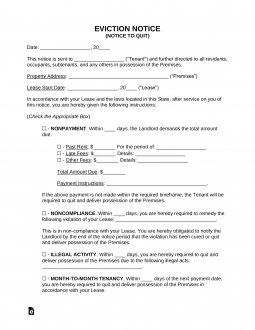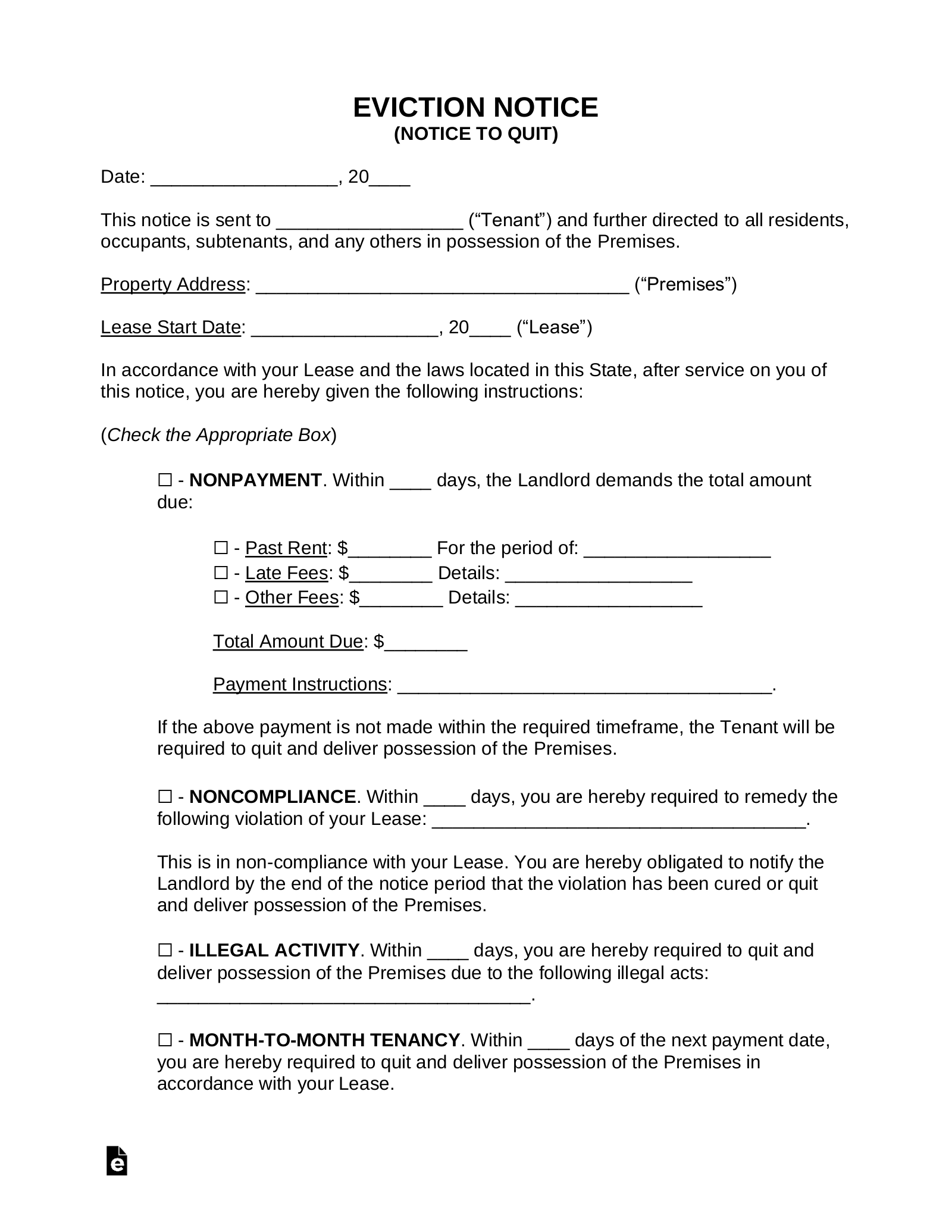Updated February 01, 2024
An eviction notice, or notice to quit, is sent by a landlord to notify a tenant of a lease violation. It grants the tenant a specified number (#) of days to cure the issue or vacate the property. If the tenant decides to leave, they will likely be liable for unpaid rent until the landlord re-rents the property.
Notice Period
If a tenant violates their lease, the landlord must provide a specified notice period in accordance with State law.
By State
- Alabama
- Alaska
- Arizona
- Arkansas
- California
- Colorado
- Connecticut
- Delaware
- Florida
- Georgia
- Hawaii
- Idaho
- Illinois
- Indiana
- Iowa
- Kansas
- Kentucky
- Louisiana
- Maine
- Maryland
- Massachusetts
- Michigan
- Minnesota
- Mississippi
- Missouri
- Montana
- Nebraska
- Nevada
- New Hampshire
- New Jersey
- New Mexico
- New York
- North Carolina
- North Dakota
- Ohio
- Oklahoma
- Oregon
- Pennsylvania
- Rhode Island
- South Carolina
- South Dakota
- Tennessee
- Texas
- Utah
- Vermont
- Virginia
- Washington
- Washington D.C.
- West Virginia
- Wisconsin
- Wyoming
Table of Contents |
By Type (4)
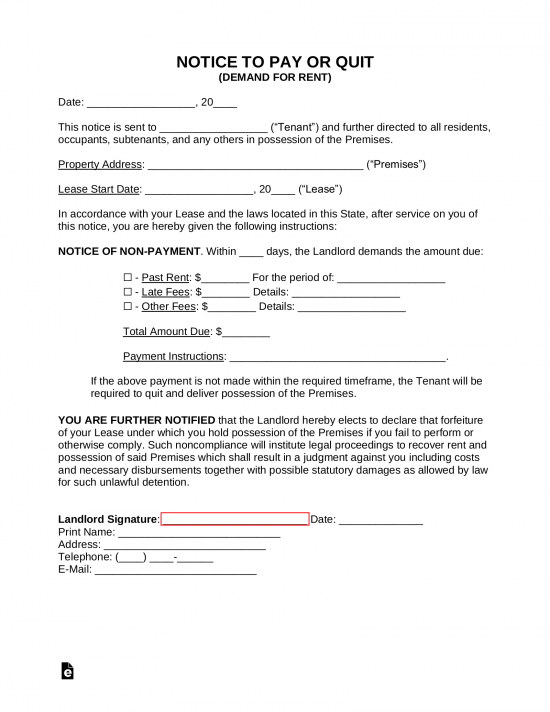 Notice to Pay ($) or Vacate – When the tenant fails to pay rent (most common). Notice to Pay ($) or Vacate – When the tenant fails to pay rent (most common).
Download: PDF, MS Word, OpenDocument
|
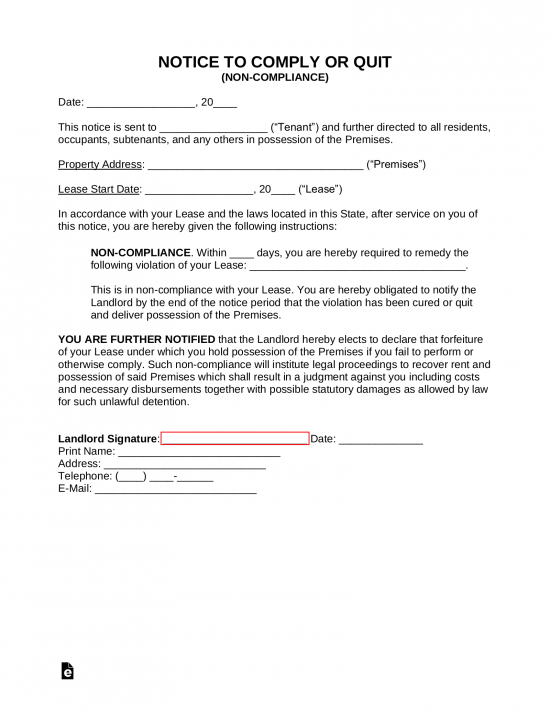 Notice to Comply or Vacate – Should be given to the tenant for any lease infraction other than the non-payment of rent. Notice to Comply or Vacate – Should be given to the tenant for any lease infraction other than the non-payment of rent.
Download: PDF, MS Word, OpenDocument
|
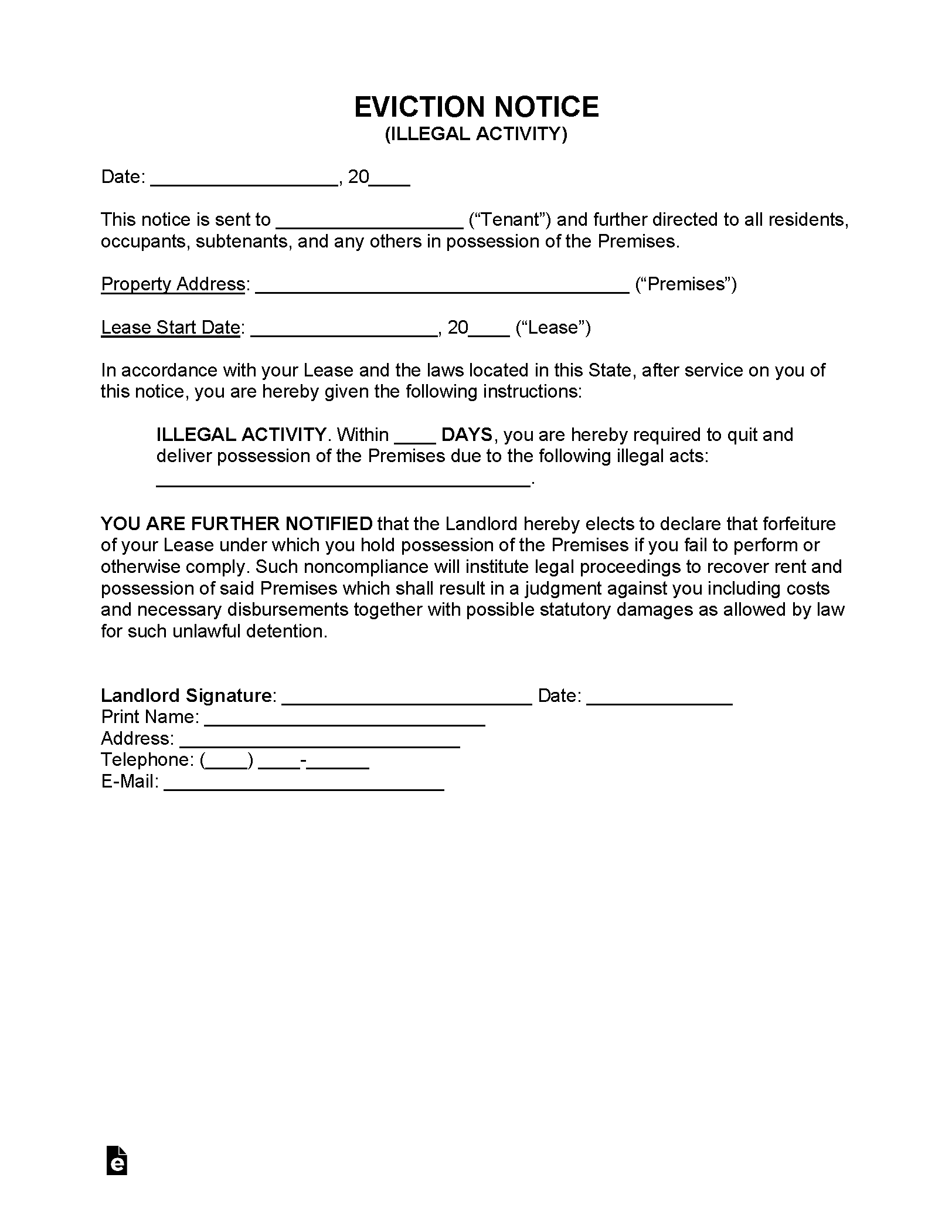 Illegal Activity – Terminates the lease between the landlord and tenant immediately. Illegal Activity – Terminates the lease between the landlord and tenant immediately.
Download: PDF, MS Word, OpenDocument |
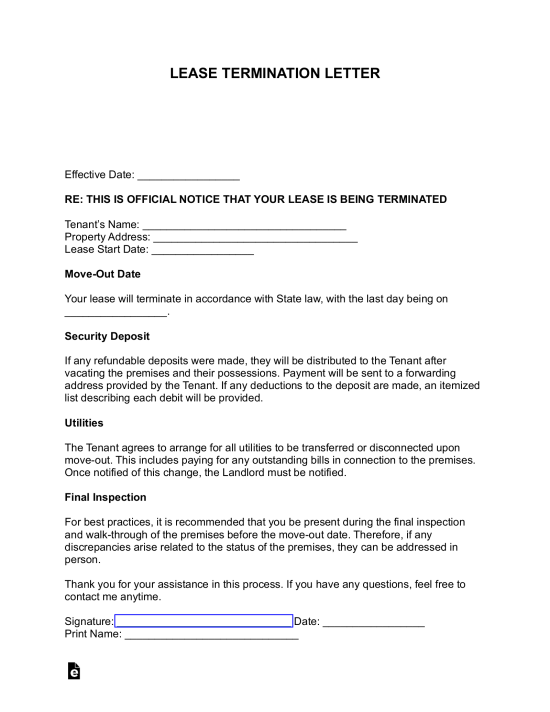 Month-to-Month Termination Letter – May be used by a tenant or landlord to cancel a tenancy at will between the parties. Month-to-Month Termination Letter – May be used by a tenant or landlord to cancel a tenancy at will between the parties.
Download: PDF, MS Word, OpenDocument |
By Number (#) of Days
What is an Eviction?
An eviction is a legal process of removing a person from possessing a residential property. Reasons for landlords to file an eviction include failure to pay rent, violating the lease terms, overstaying a rental period (tenant at sufferance), and illegal activity.
Ultimately, landlords are required to follow their state’s eviction procedure laws and can not physically remove a tenant from their property (i.e. changing the locks to the property).
Curable Notice
The tenant has a set number of days to “cure” or find a remedy to fix the violation. If not, the tenant will be required to move out.
Incurable Notice
The tenant has no option to “cure” or remedy the issue. The tenant must move out within a set number of days.
Notice Periods & Laws
How to Evict a Tenant (6 steps)
This is a general guide. It’s best to follow the specific process in the state where the property is located.
- Try to Solve the Situation
- Send the Eviction Notice
- File Eviction Papers
- Go to the Court Hearing
- Obtain the Judgment
- Collecting Past Due Rent
1. Try to Solve the Violation

Before sending an official notice, the landlord should communicate with the tenant via e-mail or text message. Since eviction notices can scare good-paying tenants, it’s best to have a calm approach that doesn’t make the tenant defensive.
Most lease violations are resolved without going past this step.
2. Send the Eviction Notice
 In order to officially start the eviction process, a landlord will need to deliver an eviction notice (notice to quit) to the tenant. Deliver the notice by posting it to the tenant’s door while also sending it by Certified Mail with a Return Receipt by the USPS.
In order to officially start the eviction process, a landlord will need to deliver an eviction notice (notice to quit) to the tenant. Deliver the notice by posting it to the tenant’s door while also sending it by Certified Mail with a Return Receipt by the USPS.
Once the tenant receives the eviction notice, they will have the opportunity to cure the violation within the allotted time frame.
It is required to send an eviction notice by any of the following methods:
- Certified mail (with return receipt)
- Hand-delivery
- Posting in a conspicuous place (e.g. on or underneath the tenant’s door)
- Standard mail (not recommended)
3. File Eviction Papers
If the tenant has not cured the violation within the timeframe outlined in the notice to quit, you can now go to your local county courthouse by bringing a copy of the return receipt and filing for the eviction. Here is a list of information that you will need to bring with you to the courthouse in order to file for your eviction against the tenant successfully:
- The address and a description, if any, of the property you are seeking to possess;
- A description of the reason for the eviction;
- A detailed account as to how and when the notice to vacate was delivered;
- An accounting of all unpaid rent and dues at the time of filing; and
- If attorney fees are being sought, include a statement with the filing.
Once filed, the court will serve a summons that orders the tenant to show up to court on a specified date.
5. Obtain the Judgment
 If you win the case, the court will allow the tenant a small amount of time in order to pack up and leave — typically around one week. In the event that the tenant does not move out at the end of their allotted timeframe, you may contact your local sheriff’s department, who will escort the tenant out of your property along with their possessions.
If you win the case, the court will allow the tenant a small amount of time in order to pack up and leave — typically around one week. In the event that the tenant does not move out at the end of their allotted timeframe, you may contact your local sheriff’s department, who will escort the tenant out of your property along with their possessions.
6. Collecting Past Due Rent and Court Fees
 The prevailing party is typically entitled to recover all court costs. Most of the time, the security deposit can cover most of the losses incurred by the landlord. If the security deposit isn’t enough, collecting is handled by going through a small claims court.
The prevailing party is typically entitled to recover all court costs. Most of the time, the security deposit can cover most of the losses incurred by the landlord. If the security deposit isn’t enough, collecting is handled by going through a small claims court.
However, it might take a while for you to collect your money. Depending on how much you owe, you may want to consider whether collecting is worth your time.
Overview (Infographic)
Sample
EVICTION NOTICE
Date: [DATE]
This notice is sent to [TENANT’S NAME] (“Tenant”) and further directed to all residents, occupants, subtenants, and any others in possession of the Premises.
Property Address: [PROPERTY ADDRESS] (“Premises”)
Lease Start Date: [LEASE START DATE] (“Lease”)
In accordance with your Lease and the laws located in this state, after service on you of this notice, you are hereby given the following instructions:
(Check the Appropriate Box)
☐ – NONPAYMENT. Within [#] days, the Landlord demands the total amount due:
☐ – Past Rent: $[AMOUNT] For the period of: [RENT PERIOD]
☐ – Late Fees: $[AMOUNT] Details: [DETAILS]
☐ – Other Fees: $[AMOUNT] Details: [DETAILS]
Total Amount Due: $[TOTAL AMOUNT DUE]
Payment Instructions: [PAYMENT INSTRUCTIONS]
If the above payment is not made within the required timeframe, the Tenant will be required to quit and deliver possession of the Premises.
☐ – NONCOMPLIANCE. Within [#] days, you are hereby required to remedy the following violation of your Lease: [DESCRIBE THE LEASE VIOLATION]
This is in non-compliance with your Lease. You are hereby obligated to notify the Landlord by the end of the notice period that the violation has been cured or quit and deliver possession of the Premises.
☐ – ILLEGAL ACTIVITY. Within [#] days, you are hereby required to quit and deliver possession of the Premises due to the following illegal acts: [DESCRIBE ILLEGAL ACTS]
☐ – MONTH-TO-MONTH TENANCY. Within [#] days of the next payment date, you are hereby required to quit and deliver possession of the Premises in accordance with your Lease.
YOU ARE FURTHER NOTIFIED that the Landlord hereby elects to declare that forfeiture of your Lease under which you hold possession of the Premises if you fail to perform or otherwise comply. Such noncompliance will institute legal proceedings to recover rent and possession of said Premises which shall result in a judgment against you, including costs and necessary disbursements together with possible statutory damages as allowed by law for such unlawful detention.
Landlord Signature: ________________________ Date: ______________
Print Name: ________________________
Address: ________________________
Telephone: (____) ____-______
E-Mail: ________________________

